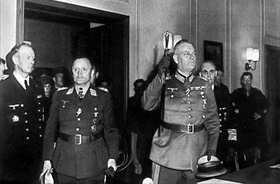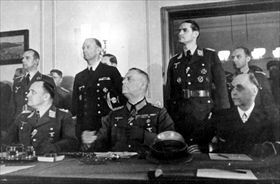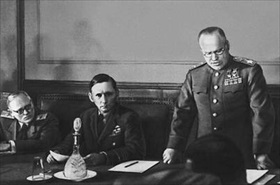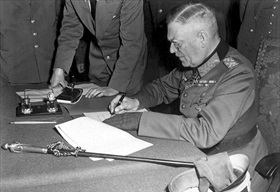GERMAN MILITARY SIGNS DEFINITIVE UNCONDITIONAL SURRENDER
Berlin-Karlshorst, Germany • May 8, 1945
Five days after the suicide of Adolf Hitler in Berlin on April 30, 1945, Adm. Hans-Georg von Friedeburg, an emissary from Grand Admiral Karl Doenitz, arrived in the French cathedral town of Reims, headquarters of Gen. Dwight D. Eisenhower, Supreme Commander Allied Expeditionary Force. For the second time in less than a week Friedeburg was tasked with opening surrender negotiations on behalf of Adm. Doenitz, Reich President of the rump Nazi government that had taken refuge in Flensburg, close to the Danish border in Northern Germany.
Friedeburg began, Eisenhower remarked later, “playing for time” so that the German armed forces could move as many men and pieces of equipment as possible behind Anglo-American lines and away from Soviet lines in Eastern Europe. Indeed, as many as 210,000 German troops had streamed into British and American lines in the last couple of days. Friedeburg was brought up short when Eisenhower’s representative and chief of staff, Gen. Walter Bedell Smith, made it plain that the Allies would only accept unconditional surrender on all fronts—and that included the Eastern Front. Doenitz complied with the demand, empowering Friedeburg’s superior, Col. Gen. Alfred Jodl, Chief of the Operations Staff of the Armed Forces High Command (Oberkommando der Wehrmacht, or OKW), to sign on May 7, 1945, in Reims formal papers of surrender of all German land, sea, and air forces everywhere in Europe.
In Soviet eyes, however, the Reims surrender was seriously flawed, and Eisenhower was in agreement. The Allied powers had agreed in 1943 that all three powers had to consent to the terms of the German surrender; from the viewpoint of Soviet dictator Joseph Stalin that had not happened and therefore his country was technically still at war with Germany. Perhaps most significantly, the terms of surrender signed in Reims required German armed forces to cease all military activities and remain in their current positions, but they were not explicitly required to lay down their arms or give themselves up to the Allies as prisoners of war. Other Soviet objections were a pretext for requiring the definitive signing ceremony to take place in the former Nazi capital of Berlin, captured by the Red Army at great cost. Conceding that the Reims act of surrender should be interpreted as “a brief instrument of unconditional military surrender,” Eisenhower joined the Soviets in pushing for a “more formal signing” between correctly accredited representatives of the German High Command drawn from all three service branches, not just the army, and properly accredited representatives of the victor nations.
Thus, on this date, May 8, 1945, twenty-four hours after the German surrender in Reims, Army Field Marshal Wilhelm Keitel, head of the entire OKW, along with representatives of the German Navy (Friedeburg) and Air Force (Col. Gen. Hans-Juergen Stumpff), signed a second unconditional surrender document in the Berlin suburb of Karlshorst. Present for the Allies were Soviet Marshal Georgy Zhukov, signing on behalf of the Supreme Command of the Red Army; Deputy Supreme Commander Allied Expeditionary Force British Air Chief Marshal Arthur Tedder, signing as Gen. Eisenhower’s representative; and French Gen. Jean de Lattre de Tassigny and U.S. Strategic Air Forces general Carl Spaatz, who signed as witnesses.
Because Doenitz’s, Jodl’s, and Keitel’s communication links with and even authority over German troops in the field were challenging, even dubious, at this juncture, some fighting continued. Certain tank regiments, fanatical Waffen-SS units (which had the most to lose from the victors), and Hitler Youth simply refused orders to lay down their arms. But the fact remained, the war in Europe was officially over after nearly 5‑1/2 years of unspeakable bloodshed and the deaths of between 65 and 85 million combatants and noncombatants. (The higher figure represents the millions who died from war-related disease and famine.) The German Reich Hitler had vowed would endure a thousand years had lasted a pitiful and extremely painful dozen.
![]()
The Definitive German Surrender in Berlin, May 8, 1945
 |  |
Left: Flown to Berlin in a British transport plane from Doenitz’s headquarters in Flensburg on the German-Danish border on May 8, the German surrender party was kept waiting from 1 p.m. to a little past midnight, May 9. By then Allied delegates had approved all redrafted and retyped changes to the definitive surrender text. Ushered into the former mess hall of a German military engineering school, now seat of the Soviet Military Administration in Berlin-Karlshorst, were Field Marshal Wilhelm Keitel (seen here in center), Chief of the General Staff of the German Armed Forces (Oberkommando der Wehrmacht) and as representative of the army; Col. Gen. Hans-Juergen Stumpff as the representative of the air force (to Keitel’s right); and Adm. Hans-Georg von Friedeburg, as Commander-in-Chief of the navy (partially hidden behind Keitel). Keitel’s baton salute to the Allied officers was cut short when it was not returned.
![]()
Right: Stumpff (left), Keitel, and Friedeburg, in strict accordance with Eisenhower’s instructions in Reims the previous day that “German commanders [were] to appear in Berlin at the moment set by the Russian High Command to accomplish a formal surrender to that Government,” were seated at a small table at right angles to the main table, their staff assembled behind them. From there they faced a military and civilian panel from the U.S., Great Britain, the Soviet Union, and France under bright Klieg lights for the benefit of news reporters, photographers, and cameramen.
 |  |
Left: Soviet host and First Belorussian Front commander Marshal Georgy Zhukov reads the terms of surrender to the German delegation. The text expanded on the Reims terms in that German forces would not only cease military operations against all Allied forces, but they would disarm themselves, disband, and be taken into captivity. Listening on Zhukov’s right is British Air Chief Marshal Sir Arthur Tedder, Deputy Supreme Commander of the Allied Expeditionary Force. Because Eisenhower, a five-star general, technically outranked Marshal Zhukov, the act of signing the German surrender document on behalf the Western Allies passed to Eisenhower’s second-in-command, Tedder.
![]()
Right: Zhukov asked the three German officers if they were prepared to sign the surrender document, which Tedder held up in his hands. Keitel replied “Ja. In Ordnung,” as he fixed his monocle over his left eye and removed his right glove. The Germans each took turns at signing the document, whose May 8, 1945, date (celebrated today as V-E, Victory in Europe, Day) had not been corrected to reflect the change of date, May 9. Then Zhukov and Tedder added their signatures as principals for the Allies, followed by de Tassigny and Spaatz as witnesses, momentarily at a loss for a pen. Zhukov declared the capitulation ceremony ended. Keitel rose, saluted again with his field marshal’s baton, and led the Germans out of the mess hall. An all-night victors banquet, followed by a car caravan tour of the vanquished Nazi capital, capped the proceedings.
Re-Enactment of Definitive German Military Surrender Ceremony in Berlin, May 8, 1945. To view, click on the link Watch on YouTube.
![]()

 History buffs, there is good news! The Daily Chronicles of World War II is now available as an ebook for $4.99 on Amazon.com. Containing a year’s worth of dated entries from this website, the ebook brings the story of this tumultuous era to life in a compelling, authoritative, and succinct manner. Featuring inventive navigation aids, the ebook enables readers to instantly move forward or backward by month and date to different dated entries. Simple and elegant! Click
History buffs, there is good news! The Daily Chronicles of World War II is now available as an ebook for $4.99 on Amazon.com. Containing a year’s worth of dated entries from this website, the ebook brings the story of this tumultuous era to life in a compelling, authoritative, and succinct manner. Featuring inventive navigation aids, the ebook enables readers to instantly move forward or backward by month and date to different dated entries. Simple and elegant! Click 











